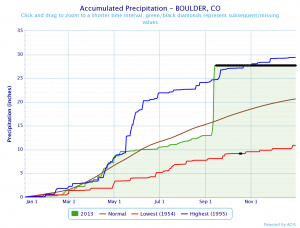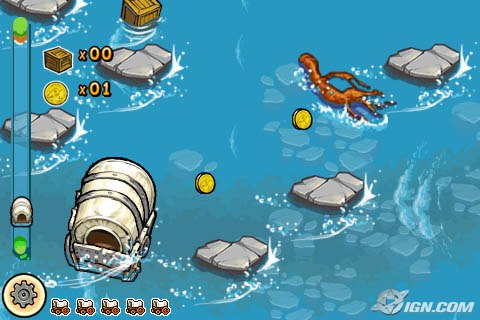I have so many thoughts about the flooding in Colorado. So much empathy for those who are affected. So much awe at the power of water. So much fear for the people who live there.
The weather conditions that came together to produce the record rainfall are not much of a mystery. Moist tropical air has been carried up from the south, with flow pointing upslope along the Rockies, providing lift. The amount of moisture in the air was record-setting by itself, and the atmosphere was primed for a heavy rain event. The weather pattern is slow-moving and stagnant, so the same moisture and the same lift have been in place for days. The result is day after day of copious rainfall.

Precipitation so far in Boulder, CO, in 2013 (green), along with the highest year on record (1995, blue), the lowest year on record (1954, red), and the average yearly rainfall (brown).
A head-spinning number of weather records have been set during this event. Boulder set an all-time record for highest rainfall in a day at 9.08 inches on September 12, blasting past the previous all-time record of 4.80 inches set on July 31, 1919. Three days in September 2013 already reside among the top 10 wettest September days on record there. September is already the all-time wettest month on record in Boulder at 14.75 inches as of this morning, with more rain already falling today and half a month yet to go.
With record rainfall comes record flooding. Record highest water levels have been recorded on numerous rivers around the Colorado Front Range, including the notorious Big Thompson Creek. The record there was previously set during a devastating and deadly flash flood in 1976 (for more information, head here.) The water is making its way down the South Platte River across northeast Colorado and into western Nebraska, where it will produce flood-level water along its reaches. Flooding has obliterated roads, homes, businesses, and lives across a wide part of the Front Range. It’s not just one creek, or one canyon, or one city. It’s a region.
I can’t bear to post any pictures of the devastation here just to “juice up” the blog, but there are a number of pictures and videos out there, with mile after mile of damage.
Meteorologist Barb wants to take this moment to talk about flood safety. And for that, I’ll start with what not to do… from our favorite little risk-taker:
This was not like wolves or cattle. The creek was not alive. It was only strong and terrible and never stopping. It would pull her down and whirl her away, rolling and tossing her like a willow branch. It would not care.
Oh, Laura. Never step into a flooding waterway! It only takes 6 inches of moving water to knock you off your feet. While we’re at it, please don’t drive into one, either. It only takes 12 inches of water to relocate a car. As a friend of a Facebook friend put it, “Don’t go all Oregon Trail here and ford the river. You’ll lose your oxen.”

Look out for the dreaded river ford…
On top of that, let’s talk for a minute about what’s in the water. It has flooded through homes, sewage treatment plants, kerosene tanks, unknown chemicals in fracking liquid, manufacturing plants, feed lots, and gas stations. The debris in the water includes dead animals large and small, chunks of buildings, pieces of trees, and mud. Don’t touch the sludge-water. If you have to touch the muck that it leaves behind, wear waterproof protective gear and wash up and disinfect afterwards.
Climatologist Barb wants to talk about things like how rare this event is. Numbers like “1000 year flood” get tossed around, so let me break down what that means. A 1000-year flood means that there is a 1 in 1000, or 0.1%, chance of that flood happening in any given year. The language is misleading because it sounds like once an event like this happens, it shouldn’t happen again for 999 years. But that’s not the case. It might just be that we didn’t have a long enough record of precipitation to see too many of these events before, but maybe they’re more common than we thought. Wild cards like climate change can make events like this more or less likely, too. (In this case, it’s probably closer to the “more likely” side as our climate continues to change, as Colorado sits in a region that is more likely to see fewer precipitation events but more extreme ones when they do come. And for the record, we aren’t able to say yet if this event has a fingerprint of climate change. But we can say that it is in line with what we expect to happen in the atmosphere in a changing climate.)
Writer friend Sandra Hume asked me for my thoughts on how rare this event is, and I answered her with this (and I tend to be an under-hype rather than over-hype kind of person):
This is an extreme event… a once-in-a-career event, right up there with the Big Thompson Canyon flood of 1976. It’s the kind of event that kills people and causes major damage no matter how good the warnings are. It’s the kind of event that will get studied for years, both on the weather side (which ingredients came together, and can we learn anything about predicting it better in the future?) and on the response/impacts side (how well did people listen to the warnings? how did people die, and what are some survival stories?). I’m sure someone will look at whether there is a tie to climate change or other climate patterns, too (though those are always hard to peg for weather events like this). People will tell stories about it. It will set a new bar for flooding. It will inspire some children to become meteorologists, hydrologists, or swiftwater rescuers. It’s that big of an event.
I can’t do a better job than colleague Bob Henson did in describing the rarity of this event, so I’ll take you right to his words on the UCAR web site.
My heart goes out to everyone who is affected by these floods — a great many friends and colleagues are in the path of the deluge, and it hurts to see the impact to them as well as to the beautiful landscape of this piece of Colorado land.
The creek would go down. It would be a gentle, pleasant place to play in again. But nobody could make it do that. Nobody could make it do anything. Laura knew now that there were things stronger than anybody. But the creek had not got her. It had not made her scream and it could not make her cry.

Just a slight clarification. This was a 1000 year rainfall event according to NOAA Atlas 14 (more than 10 inches in three days). However, determining the return period of a flood depends not only on rainfall but antecedent rainfall conditions, soil dryness, areal extent, etc. I think the USGS usually takes a while to determine the flood return period. But the probability of occurrence is exactly right; a 1000 year rainfall has a 0.1 percent chance of happening in any year, and it could happen again next year. But I certainly hope and pray not.
Thanks for the clarification, Pam, and great to see you here!
Thanks, Barb, for your Little House tie-in with these unprecedented Colorado floods. I was working in Estes Park during both the 1976 Big Thompson and the 1982 Lawn Lake Dam floods, seeing first-hand the power of extreme rainfall rushing down mountain canyons. This 2013 water was even more devastating than any predictions made on Flood Plan maps. Our Longmont area had just finished a 3-year project reworking the Left Hand Creek corridor for a 100-year flood — the water went so far beyond the predicted zones that it verified the 500- or 1000-year flood label. The force and power of water over hundreds of miles in Colorado are hard to grasp through the TV news photos. The roads, homes, businesses, people, animals and sheer beauty of northern Colorado will be forever changed by the high water mark of the 2013 Flood.
On a personal note, Mac and I live in a hillside neighborhood just 1/2 mile north of the confluence of the St. Vrain and Left Hand creeks. We stayed “hi & soggy” with no flooding in our basement or window wells. We walk our dogs along the river paths that are now gone. So many friends affected in Longmont, Boulder, Lyons, Firestone, and beyond. My 80-year-old parents were still in our family summer cabin in Estes Park and on a mountainside, thankfully, with no flooding. However, they just winterized the cabin and were able to drive out of Estes Park on the only emergency road remaining to the east toward Denver and on home to Texas. My nephew is staying in Estes to continue working and staying with a friend awhile longer. The two major canyon highways to Estes Park, US 36 and US34, are both washed out; will be months before repairs are possibly completed.
Thanks again for your commentary on this historic event.
Thanks for you very up close and personal perspective on this event (and its predecessors). Your words really nailed it — everything about that region of Colorado will change because of these floods. I’m glad to hear that your house is OK and that your parents made it out all right. It’s going to take a long time to get those roads rebuilt.
I experienced a major flood event in eastern KY in May 1984 (I had only been in the NWS a year!). I lived a mile from a river in a trailer home and thought I would be safe. Wrong! The river was flowing right through the trailer and ruined everything. The NWS is up on the top of one of the mountains and I was essentially trapped for 30 hours before a chinook helicopter “rescued” me. (All the roads were flooded you see). That was enough for me and have never lived near a river, creek or even a pond ever since for fear these extreme events would happen again to me. My heart goes out to those people in the flood and pray they don’t have to experience that again!
Thanks for sharing your story, John! One extreme event really can shape us for the rest of our lives.
Barb would you please write about the recent blizzard in the Dakotas. It being so early made me think about the Long Winter every time I heard a report. Is this a for-telling of the winter to come for the area? Will it be another Long Winter type of winter for that area? Thanks for your input.
Ask and you shall receive! I’m working on something now. Look for it to post later today or tomorrow 🙂